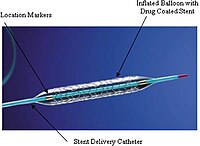
Photo from wikipedia
Stent size selection and placement are among the most challenging tasks in the treatment of pulmonary artery stenosis in congenital heart defects (CHD). Patient-specific 3D model from CT or MR… Click to show full abstract
Stent size selection and placement are among the most challenging tasks in the treatment of pulmonary artery stenosis in congenital heart defects (CHD). Patient-specific 3D model from CT or MR improves the understanding of the patient's anatomy and information about the hemodynamics aid in patient risk assessment and treatment planning. This work presents a new approach for personalized stent design in pulmonary artery interventions combining personalized patient geometry and hemodynamic simulations. First, the stent position is initialized using a geometric approach. Second, the stent and artery expansion, including the foreshortening behavior of the stent is simulated. Two stent designs are considered, a regular stent and a Y-stent for bifurcations. Computational fluid dynamics (CFD) simulations of the blood flow in the initial and expanded artery models are performed using patient-specific boundary conditions in form of a pulsatile inflow waveform, 3-element Windkessel outflow conditions, and deformable vessel walls. The simulations have been applied to 16 patient cases with a large variability of anatomies. Finally, the simulations have been clinically validated using retrospective imaging from angiography and pressure measurements. The simulated pressure, volume flow and flow velocity values were on the same order of magnitude as the reference values obtained from clinical measurements, and the simulated stent placement showed a positive impact on the hemodynamic values. Simulation of geometric changes combined with CFD simulations offers the possibility to optimize stent type, size, and position by evaluating different configurations before the intervention, and eventually allow to test customized stent geometries and new deployment techniques in CHD.
Journal Title: Journal of biomechanics
Year Published: 2018
Link to full text (if available)
Share on Social Media: Sign Up to like & get
recommendations!